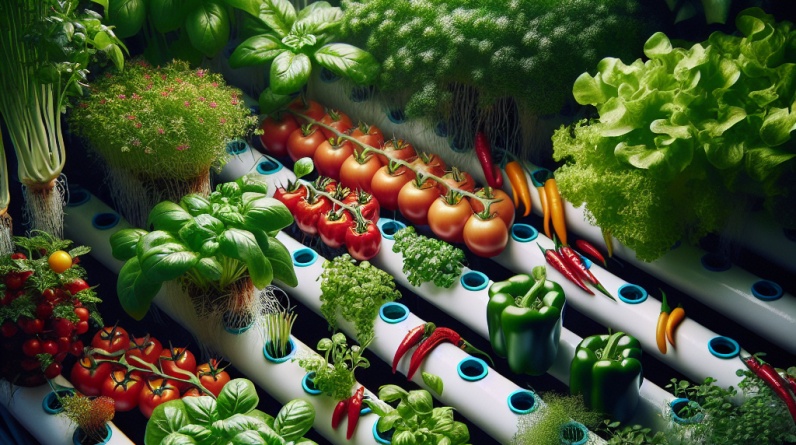
Understanding Hydroponics
What is Hydroponics?
So let’s dive right in. Hydroponics is basically a method of growing plants without soil! Sounds wild, right? Instead, plants thrive in a nutrient-rich water solution. I’ve always been amazed by how versatile this method is. You can literally grow a variety of crops in a small space with minimal resources.
When I first stumbled upon this technique, I thought it was only for fancy, high-tech greenhouses. But the truth is, anyone can set up a hydroponic system at home! From herbs to vegetables, the options are endless. It’s all about understanding the different types of setups, like deep water culture or nutrient film technique.
My personal experience with hydroponics has shown me that anyone, even those with a black thumb, can successfully grow plants this way. No mess, no soil pests, and plants can grow much faster—what’s not to love?
Benefits of Hydroponic Crops
Efficient Space Usage
One of the coolest perks of hydroponic gardening is the efficient use of space. You can pack plants right next to each other and still have them flourish. This way, even if you’re working with a tiny balcony or an urban rooftop, you can maximize your growing area.
Believe me, I’ve had my fair share of garden space struggles. With traditional gardening, it felt like I always needed more dirt! But with hydroponics, I’ve grown everything from lettuce to strawberries in just a few square feet. It’s amazing how much you can fit into such a limited area!
Additionally, vertical gardening setups are a game-changer. By stacking your plants, you not only save space but can also create a stunning visual effect. Seriously, my vertical hydroponics setup has become a conversation starter among my friends!
Types of Hydroponic Systems
Variations on the Basic Setup
Now, let’s talk about some of the different hydroponic systems I’ve had the chance to experiment with over the years. The key types include Wick Systems, Ebb & Flow, Nutrient Film Technique (NFT), and AquaPonics. Each of these systems has its quirks and benefits.
For example, I started with a simple Wick System. It’s incredibly low maintenance—great for beginners! Just make sure your plants are compatible with this type of system since not all crops do well. Over time, however, I moved on to the Ebb & Flow system for its efficiency in delivering nutrients.
I can’t stress enough the importance of choosing the right system for your needs and space. Each type can yield different results, so it’s worth doing a little research or talking to fellow hydroponics enthusiasts to find the best fit for you!
Crops That Thrive in Hydroponics
Getting Creative with Crop Choices
You might be surprised at the variety of crops that thrive in hydroponic systems. I started with easy-to-grow options like herbs—basil, dill, and mint. These were not only simple but also super rewarding to harvest and use in my cooking!
After I got the hang of it, I decided to try my hand at leafy greens, which are fantastic in hydroponics. Lettuce, kale, and spinach grow phenomenally well and you can literally watch them grow day by day. It was thrilling the first time I harvested my own greens—nothing beats the taste of fresh produce!
Then I got daring and started growing fruiting plants like tomatoes and peppers in my hydro setup. It was challenging but oh-so rewarding. Seeing those ripe tomatoes slowly come to life made all the learning and experimentation worthwhile!
Challenges and Solutions in Hydroponics
Common Troubles and How to Tackle ‘Em
Now, it’s essential to face some of the challenges head-on. Hydroponics, while fantastic, isn’t always smooth sailing. I faced a few bumps along the way, especially with pH balance and nutrient solutions. Sometimes, you can get too caught up in the excitement and overlook these crucial elements!
What I found helpful was keeping a close eye on the water quality and regularly testing pH levels. It took me a few tries to find the right balance, but investing in a good pH meter made a huge difference. Monitoring your water regularly can save you from some major headaches later.
Another challenge is pests, which like to sneak in when you least expect it. I discovered natural pest management techniques work best, instead of reaching for harsh chemicals. Neem oil became my go-to solution—a natural way to keep those pesky bugs in check while keeping my plants healthy. It’s all about being prepared and proactive!
FAQs
What is hydroponics?
Hydroponics is a method of growing plants in a nutrient-rich water solution instead of soil.
What crops can I grow using hydroponics?
You can grow a variety of crops such as leafy greens, herbs, and even fruits like tomatoes and strawberries!
Are there any challenges in hydroponic gardening?
Yes, challenges include maintaining the proper pH level, water quality, and protecting your plants from pests.
Do I need a lot of space for a hydroponic setup?
Nope! Hydroponic systems can be set up in small spaces, like balconies or even indoors, making it perfect for urban gardening.
Is it easy to get started with hydroponics?
It can be quite easy, especially with beginner-friendly systems. Start with simple crops and gradually explore different setups!








